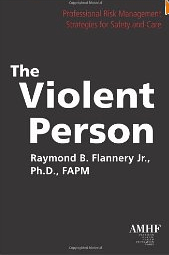“The Violent Person”

‘Invaluable’ resource looks at ethical dilemmas
“The Violent Person”
By Raymond B. Flannery
American Mental Health Foundation, Inc.
Riverdale, N.Y., 2009
Reviewed by James K. Luiselli, Ed.D., ABPP, BCBA-D
What constitutes a behavioral emergency? According to psychologist Raymond B. Flannery, it represents a “medical or psychiatric crisis,” which “poses the risk of imminent, violent behavior toward the responding healthcare professional, the agitated victim, innocent family members, or bystanders.” “The Violent Person” is intended as a risk management guide for practitioners who encounter or are likely to experience such events.
The book’s target audience includes health care providers and emergency services personnel who may be new to their professions. Accordingly, much of the information, including practice recommendations is presented at a basic level. The author cautions, however, that his “safety and self-care guidelines require considerable clinical study and experience and should not be fielded by anyone in the absence of such training.” I agree with Flannery’s caveat that by itself, the book is not sufficient for teaching crisis management skills.
The book describes violence against medical, mental health, social services and emergency-response practitioners as an occupational hazard. A good portion of its content is based on the Assaulted Staff Action Program (ASAP), a prevention and intervention model Flannery created 20 years ago. Various forms, methods and data from the ASAP are presented.
Early chapters in the book address the critical topic of risk assessment. Essentially, Flannery advises practitioners to carefully consider several factors before intervening in a crisis situation. They include a patient’s documented chart history, medical condition and psychiatric status, as well as observable warning signs. His outline for conducting in vivo assessment is good but arguably abbreviated and meant as a first-phase risk screening.
Notwithstanding the book’s pragmatic focus, most of the chapters are condensed reviews of medical and psychological explanations of violent behavior and associated consequences. For example, Flannery writes about theories of violence, posttraumatic stress disorder, child maltreatment, persistent mental illness and youth crime.
These chapters are helpful because they properly consider the complex reciprocity between causes and effects of human violence. They also feature case studies which illustrate how to adapt risk management strategies to different types of behavioral emergencies.
Some of the best chapters in the book have to do with practitioner self-care. Concerning self-defense during potentially volatile interactions, Flannery makes cogent suggestions about non-verbal communication, wardrobe, verbal de-escalation and avoidance of physical confrontation. He also recommends that people in high-risk vocations be keenly aware of life-stress issues. On this topic, he lists simple but time-tested wellness approaches related to nutrition, exercise and away-from-the-job free time.
“The Violent Person” is a solid contribution that can be used for training staff in crisis management. The book would also be valuable for program administrators in designing clinical safety protocols for their employees. And, as Flannery suggests, general readers interested in understanding human violence, its causes and prevention, may find it an informative resource. It is easy to read, contemporary and certainly covers a complex societal problem.
James K. Luiselli, Ed.D., ABPP, BCBA, is senior vice president, applied research, clinical training and peer review at the May Institute in Norwood, Mass.
Learn more about the book: The Violent Person: Professional Risk Management Strategies for Safety and Care
